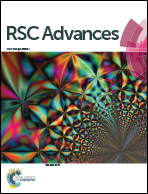A triazine-based porous organic polymer: a novel heterogeneous basic organocatalyst for facile one-pot synthesis of 2-amino-4H-chromenes†
Abstract
A new triazine-based porous organic polymer TPOP-2 has been synthesized through the reaction between cyanuric chloride and tris(2-aminoethyl)amine in anhydrous 1,4-dioxane under N2 atmosphere. The porous polymer has been characterized by powder X-ray diffraction, N2 sorption, HR TEM, FE SEM, 13C CPMAS NMR, CO2-TPD, TG-DTA and FT IR spectroscopic tools. Due to the high density of amine and triazine functional groups, this porous polymer is N-rich and possesses excellent surface basicity, and is utilized as a heterogeneous metal-free basic organocatalyst for the one-pot three-component condensation reaction of aromatic aldehyde, activated phenols (resorcinol and 2-naphthol) and malononitrile for the synthesis of 2-amino-chromenes under solvent-free or aqueous conditions. The ease of catalyst synthesis and its efficient use for five consecutive cycles without noticeable loss in catalytic activity suggest significant future potential of this new N-rich porous organic polymer material for a wide range of base catalyzed reactions.


 Please wait while we load your content...
Please wait while we load your content...